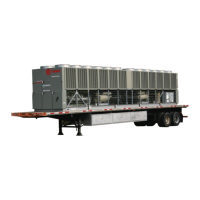31
RLC-SVX02G-E4
Installation - Mechanical
Install a strainer in the evaporator-
water inlet piping. Failure to do so
can result in evaporator tube
damage.
Leaving Chilled-Water
Piping
[ ] Air vents (to bleed air from
system).
[ ] Water pressure gauges with
shutoff valves.
[ ] Vibration eliminators.
[ ] Shutoff (isolation) valves.
[ ] Thermometers.
[ ] Clean out tees.
[ ] Balancing valve.
[ ] Flow Proving Device
To prevent evaporator damage, do
not exceed 150 psig (10.5 bar)
evaporator water pressure.
Evaporator Drain
A ½" drain connection is located
under the outlet end of the
evaporator water box. This may be
connected to a suitable drain to
permit evaporator drainage during
unit servicing. A shutoff valve must
be installed on the drain line.
Drainage will be done at each end of
the 2 water boxes.
In case of winter water drainage for
freeze protection, it is compulsory to
disconnect the evaporators heaters
to protect them from burning due to
overheat.
Evaporator Flow Proving
Device
Specific connection and schematic
wiring diagrams are shipped with
the unit. Some piping and control
schemes, particularly those using a
single water pump for both chilled-
water and hot water, must be
analyzed to determine how and/or if
a flow-sensing device will provide
the desired operation.
Flow Switch Installation - typical
requirement
1. Mount the switch upright, with a
minimum of 5 pipe diameters of
straight horizontal run on each
side. Do not install close to
elbows, orifices, or valves.
Note: The arrow on the switch must
point in the direction of flow.
2. To prevent switch fluttering,
remove all air from the water
system.
Note: The CH.530 provides a
6 second time delay after a “loss-
of-flow” diagnostic before
shutting the unit down. Contact a
qualified service representative if
nuisance machine shutdowns
persist.
3. Adjust the switch to open when
water flow falls below nominal.
Evaporator data is given in the
General information Section.
Flow-switch contacts are closed
on proof of water flow.
4. Install a pipe strainer in the
entering evaporator-water line to
protect components from
waterborne debris.
Control voltage from the chiller to
the flow proving device is 110V ac.
Water Treatment
If calcium chloride is used for waste
treatment, an applicable corrosion
inhibitor must also be used. Failure
to do so may result in damage to
system components.
Dirt, scale, products of corrosion,
and other foreign material will
adversely affect heat transfer
between the water and system
components. Foreign matter in the
chilled-water system can also
increase pressure drop and,
consequently, reduce water flow.
Proper water treatment must be
determined locally, depending on
the type of system and local water
characteristics.
Neither salt nor brackish water is
recommended for use in Trane air-
cooled Series R
TM
chillers. Use of
either will lead to a shortened life to
an indeterminable degree. Trane
encourages the employment of a
reputable water treatment specialist,
familiar with local water conditions,
to assist in this determination and in
the establishment of a proper water-
treatment program.
Do not use untreated or improperly-
treated water. Equipment damage
may occur.
Entering Chilled-Water
Piping
[ ] Air vents (to bleed air from
system).
[ ] Water pressure gauges with
shutoff valves.
[ ] Vibration eliminators.
[ ] Shutoff (isolation) valves.
[ ] Thermometers (if desired).
[ ] Clean out tees.
[ ] Pipe strainer.
